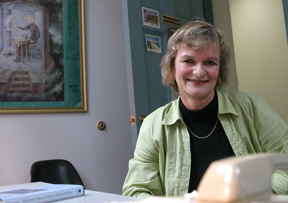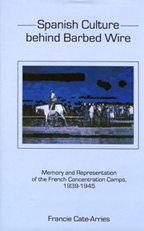Humanity discovered in the French concentration camps, Cate-Arries’ book seeks the spirit of the Spanish exile
 Francie Cate-Arries' first book is not the one she set out to write. Entitled Spanish Culture Behind Barbed Wire,
her account of the Spanish exile experience in French concentration
camps following Franco's coup in 1939 was to be at most an introduction
to her intended celebration of the contributions approximately 25,000
of the exiles ultimately would make in the cultural life of Mexico
City.
Francie Cate-Arries' first book is not the one she set out to write. Entitled Spanish Culture Behind Barbed Wire,
her account of the Spanish exile experience in French concentration
camps following Franco's coup in 1939 was to be at most an introduction
to her intended celebration of the contributions approximately 25,000
of the exiles ultimately would make in the cultural life of Mexico
City.
The prologue, she soon realized, was the story.
It was not the suffering of the fleeing Republican soldiers and citizens that convinced her. Although dire depictions of a quarter-million exiles interned for extended periods in makeshift concentration camps on the exposed beaches of France were both troubling and tragic, Cate-Arries, associate professor of Hispanic studies at the College, discovered a more compelling narrative.
“Once I started reading the testimonies, these people's oral histories, I was intrigued because despite the dire conditions, the physical hardship, the anguish of having lost family members during the war and having been separated during exile, … what inspired me to continue with this as a book was this incredible sense of perseverance and survival,” she said.
By looking at the voices of exile—including representative
art and literature—Cate-Arries' book goes beyond the histories of the
concentration camps that began emerging after Franco's death in 1975.
She uses these sources to show a nation without a physical place
defining itself as it created a collective memory. Excerpts she
includes become a camp chronology. 
Juan Carrasco's description, “The sand was our floor, the sky our roof and the doorway out was the sea,” hints at the barrenness of the camp locations. Lluis Ferron de Pol's reaction goes further; “In this place that apparently has been assigned to us, there is a kind of reed and a few blades of grass. Nothing else. Not a single tree, no canebrake, no barracks, nor any type of refuge from the cold and the wind. Absolutely nothing. Sand and solitude. …We are just prisoners and we will have to get used to the idea. A barbed-wire fence is not just a holding area but, in fact, a prison.”
The omnipresent guards become a theme, illustrated by Molins i Fabrega, who wrote, “The gendarme who insulted you during the day, who treated you like a Spanish pig, and who beat you to get your weak body up an moving, has robbed the devil of his wings and flies … between you and the spaces of infinity, ready to open fire against your very thoughts if you dare to escape in dreams ….”
The camps, although brutal, did not extinguish hope. Suffering was due more to overcrowding and lack of material support from a French government overwhelmed by the influx and wary of becoming politically antagonistic against the new Spanish regime headed by Franco—and his suspected ties to Hitler. Camp inhabitants, many of whom remained interned well into the period of World War II, nevertheless struggled valiantly to retain health and sanity. Cate-Arries includes accounts of camp residents caring for each other and building a community from the meager items at their disposal. One poignant example involved exiles making brooms from barbed wire in order to sweep the sand, which had become their floors. But there were efforts at a higher organization.
“I was intrigued to learn about the schools they started in these camps,” Cate-Arries said. “They tried to teach people to read and write. There were classes in history, classes in literature, poetry readings, and art exhibits. There were political meetings. So these people who had just fought the war were still fighting the war. They struggled not only to physically survive but to keep alive the flame of their beliefs. They weren't just victims; they were activists—to the extent you can be an activist when you're enclosed in barbed wire.”
For Cate-Arries, the story of the exiles does not end with the closing of the camps in the early 1940s. Their literature and art, largely unknown in Spain until after Franco’s death, are part of a national legacy that is finally being recognized. They also are contiguous with the larger stories of refugees and exiles attempting to build community in displacement.
“You read these stories and just the common humanity is the story that is being told,” Cate-Arries said. “Obviously there's a political story being told regarding the positions of the writers, but there's even more at the core, this common human struggle that kind of reminds us of what matters.”
She refers to work she has done at the Spanish Cultural Center in Mexico City where she began research on the Spanish exile community. There the director, a former Spanish Civil War refugee, herself, every day mentions the status of one or more refugee groups somewhere in the world.
“That's the sad part about it. It's not a story that is over in 1945 in Europe,” Cate-Arries said. “It's a story that continues to unfold.”
 Skip to main content
Skip to main content
